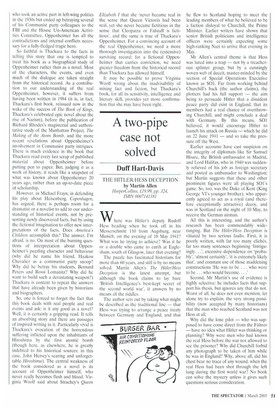A two-pipe case not solved
Duff Hart-Davis
THE HITLER/HESS DECEPTION by Martin Allen HarperCollins, £19.99, pp. 324, ISBN 0007141181 Where was Hitler's deputy Rudolf Hess heading when he took off in his Messerschmitt 110 from Augsburg, near Munich, on the evening of 10 May 1941? What was he trying to achieve? Was it he or a double who came to earth at Eaglesham, south of Glasgow, later that evening?
The puzzle has fascinated historians for more than 60 years, and still is by no means solved. Martin Allen's The Hitler/Hess Deception is the latest attempt, but although the book claims to lay bare 'British Intelligence's best-kept secret of the second world war', it answers by no means all the riddles.
The author sets out by taking what might be described as the traditional line — that Hess was trying to arrange a peace treaty between Germany and England, and that he flew to Scotland hoping to meet the leading members of what he believed to be a faction disloyal to Churchill, the Prime Minister. Earlier writers have shown that senior British politicians and intelligence officers were certainly expecting some high-ranking Nazi to arrive that evening in May.
Mr Allen's central theme is that Hess was lured into a trap — not by a treacherous splinter group, but by a cunningly woven web of deceit, master-minded by the section of Special Operations Executive known as S01. Far from working behind Churchill's back (the author claims), the plotters had his full support — the aim being to persuade Hitler that a dissident peace party did exist in England, that its members had a real chance of overthrowing Churchill, and might conclude a deal with Germany. By this means, SO1 believed, it would encourage Hitler to launch his attack on Russia — which he did on 22 June 1941 — and so take the pressure off the West.
Earlier accounts have cast suspicion on the integrity of diplomats like Sir Samuel Hoare, the British ambassador in Madrid, and Lord Halifax, who in 1940 was suddenly relieved of his job as foreign secretary and posted as ambassador to Washington; but Martin suggests that these and other prominent figures were all playing SO l's game. So, too, was the Duke of Kent (King George VI's younger brother), who apparently agreed to act as a royal (and therefore exceptionally attractive) decoy, and was in Scotland on the night of 10 May, to receive the German airman.
All this is interesting, and the author's research has been commendably wideranging. But The Hider/Hess Deception is vitiated by two serious faults. First, it is poorly written, with far too many clichés, far too many sentences beginning 'Intriguingly. . .', excessive dependence on 'probably', 'almost certainly', 'it is extremely likely that', and constant use of those maddening constructions 'He was to be . . . who were to be ... who would become. ..
Second, Mr Martin's use of evidence is highly selective: he includes facts that support his thesis, but ignores any that do not. Worst of all, he does not even mention, let alone try to explain, the very strong possibility (now accepted by many historians) that the man who reached Scotland was not Hess at all.
Why did the lone pilot — who was supposed to have come direct from the Fuhrer — have no idea what Hitler was thinking or planning? Why were men who had known the real Hess before the war not allowed to see the prisoner? Why did Churchill forbid any photograph to be taken of him while he was in England? Why, above all, did his chest bear no trace of any wound, when the real Hess had been shot through the left lung during the first world war? No book can solve the mystery unless it gives such questions serious consideration.


















































































 Previous page
Previous page